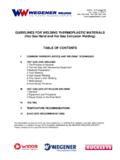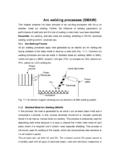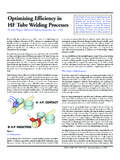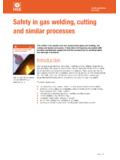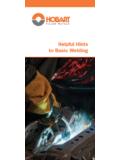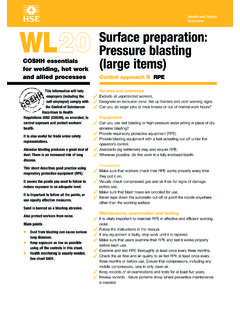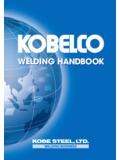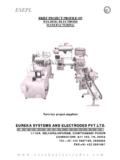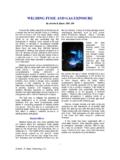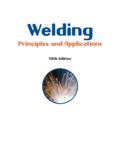Transcription of THERMOPLASTICS WELDING IN INDUSTRIAL …
1 16W301 S Frontage Rd Burr Ridge, IL 60527 Phone 630-789-0990 FAX 630-789-1380 THERMOPLASTICS WELDING IN INDUSTRIAL fabrication (OVERVIEW) SCOPE The use of thermoplastic materials is not well known in the world of fabricated products. While THERMOPLASTICS may have limitations with regard to the operating temperature or operating pressure of a fabricated structure, they very often present an excellent alternative to metals due to some inherent characteristics. Depending on the application, THERMOPLASTICS may far outlast metals in the areas of corrosion, resistance to chemicals or abrasion. One rapidly growing area of THERMOPLASTICS is in piping systems, for example in applications for water, sewer, drainage, irrigation, natural gas, chemicals and pharmaceuticals. Rotationally molded containers and tanks see an increasing popularity. How many of us actually realize that our landfills today are lined and covered with welded thermoplastic membranes to prevent groundwater contamination and air pollution?
2 Not very widely known is the ability to use plastic sheet stock to fabricate custom built structures to satisfy specific requirements. Structures made out of fabricated thermoplastic sheet are found in the plating and galvanizing industry, in air pollution control systems, wastewater treatment systems, emergency vehicles, in chemical, biochemical and pharmaceutical process systems or in various areas of manufacturing semiconductor components, just to name a few. In addition to structural design and selection of the appropriate material, the jointing technology evolves as the key factor in the fabrication of a successful structure. Fume scrubber Plating tank 16W301 S Frontage Rd Burr Ridge, IL 60527 Phone 630-789-0990 FAX 630-789-1380 MATERIALS The industry offers a multitude of different thermoplastic resins. The most common ones are Polypropylene (PP), Polyethylene (PE) and Polyvinylchloride (PVC).
3 With the addition of additives or changes in the manufacturing processes of these resins, subgroups were developed to meet specific criteria. These include Co-Polymer Polypropylene (PP type II), PVC type II or CPVC, which is PVC with higher chlorination content. In the PE family, the material density or molecular weight provides for numerous classifications such as Low Density Polyethylene (LDPE), Linear Low Density Polyethylene (LLDPE), High Density Polyethylene (HDPE), High Molecular Weight Polyethylene (HMWPE) and Ultra High Molecular Weight Polyethylene (UHMWPE). Materials are continuously being developed to meet particular application requirements. If these materials do not satisfy particular requirements, an entire group of higher engineered materials is available. These include Polyvinylidene Fluoride (PVDF), Ethylene Clortrifluorethylen (ECTFE), Tetrafluorethylene Perfluormethyl Vinylether Copolymer (FEP), Tetrafluorethylene Perfluormethyl Vinylether (MFA) and Perfluoralkoxy Copolymer (PFA), These materials typically have higher chemical and temperature resistance but carry a higher cost.
4 With the exception of PVDF and ECTFE, these materials are mostly used as linings in FRP constructions and require special expertise with respect to WELDING and fabrication . WELDING A quality thermoplastic weld requires that the execution of the weld be performed under the proper conditions and parameters. WELDING means the heating of the materials to their specific WELDING temperature ( thermoplastic state), applying a certain amount of pressure for the molecules to intermingle and allowing the material to cool down under pressure. The following criteria need to be observed - material compatibility - suitable weld type and weld configuration - observation of correct WELDING parameters - clean WELDING surfaces The WELDING parameters are material and process specific. The typical WELDING processes are: - hot gas (air) hand WELDING - hot gas (air) extrusion WELDING - heated tool butt WELDING - bending 16W301 S Frontage Rd Burr Ridge, IL 60527 Phone 630-789-0990 FAX 630-789-1380 Hot gas (air) hand WELDING and hot gas (air) extrusion WELDING are manual processes and therefore the quality of the weld is highly dependent on the skill and attention level of the operator.
5 Both methods use a filler material to perform the weld. The gas (air) is required to simultaneously transmit heat into the parent materials and the WELDING rod to allow the molecular interlocking to take place. The primary difference between the two methods is the size of the weld generated. Standard WELDING rod sizes in hot gas (air) hand WELDING are round rod 1/8 , 5/32 and 3/16 diameter. Some industries prefer to use a triangular shaped rod, especially for cosmetic purposes. Due to the poor heat conductivity of THERMOPLASTICS there is a limit as to the size of WELDING rod that can be used. WELDING of heavier gauge sheet therefore requires multiple passes to obtain adequate weld size, a time consuming task. Multiple passes also create unnecessary stress in the parent material due to the continuous heating and cooling sequence. Provided there are no physical or material constraints, extrusion WELDING is the preferred method to replace multiple pass welds.
6 HOT GAS (AIR) HAND WELDING A hot gas (air) hand WELDING system consists of a WELDING gun (torch), a clean air supply unit and a WELDING nozzle (tip). A dedicated pyrometer with a needle style probe should be on hand to provide accurate verification of the WELDING temperature. Additional tools are material scrapers and cleaning brushes for the tips. The design of the WELDING gun should provide for electronic adjustment of the WELDING temperature. The air supply needs to be clean, oil and moisture free to prevent contamination of the weld. A constant air volume is required to keep the set temperature in the correct range. After lining up the materials, the first step is to tack them together. Tack WELDING is performed without a filler material by moving a pointed tacking tip along the area to be welded. The tack weld assures that all parts are in place and that the materials stay in position when the actual WELDING operation is performed.
7 After tack WELDING , the weld area should be scraped to remove the oxidation layer created by the hot air during the tacking process. 16W301 S Frontage Rd Burr Ridge, IL 60527 Phone 630-789-0990 FAX 630-789-1380 WELDING gun with tacking tip The most common form of hot gas (air) WELDING is called high speed WELDING . The high speed WELDING tip is designed to guide the WELDING rod into the weld zone while simultaneously heating up the rod and the base material. The shoe at the end of the rod orifice allows the operator to apply the WELDING pressure. The WELDING pressure is dependent on material type and rod size. The key to quality hot gas (air) WELDING is the correlation of constant temperature, speed, pressure and air volume. High speed WELDING HOT GAS (AIR) EXTRUSION WELDING 16W301 S Frontage Rd Burr Ridge, IL 60527 Phone 630-789-0990 FAX 630-789-1380 The technology of manufacturing plastic sheet, pipe, rod and tubing is used on a miniature scale in the hot gas (air) extrusion WELDING process.
8 An extrusion screw inside a melting chamber processes 5/32 or 3/16 diameter WELDING rod coming off a spool and supplies a fully molten, plasticized strand of material in a larger diameter. The design and size of the weld is determined by a Teflon (PTFE) shoe, which is mounted to the end of the melting chamber. PTFE is the material of choice as it has a very low coefficient of friction and is easily machined. To preheat the parent material, a hot air system is mounted on the side of the machine with the outlet right in front of the Teflon shoe. Depending on application, these systems may be self-contained with an internal air supply, or may require connection to an external air supply. Hot air extrusion welder Both hot gas (air) hand and hot gas (air) extrusion WELDING are manual operations. The quality of the weld is highly dependent on operator knowledge and skill. HEATED TOOL BUTT WELDING 16W301 S Frontage Rd Burr Ridge, IL 60527 Phone 630-789-0990 FAX 630-789-1380 Very popular in the PP, HDPE and PVDF piping industry, heated tool butt WELDING can also be performed with sheet materials.
9 The process does not use filler material, but involves a heated bar located between two moving tables. The sheet is clamped onto the tables against a setting bar. Once set, a heating bar moves into place against the two sheets being held. The machine then goes through a three-stage cycle of heating the material using two different pressures, moving the heating bar out of the way and pressing the sheet together under a higher pressure. Temperatures, times, pressures and pressure ramps are dependent on the type of material and the overall surface to be welded. Most machines are microprocessor equipped to facilitate setting of the machine and assure full repeatability. Provided the parameters are set correctly, heated tool butt WELDING is considered the strongest weld. Sheet Butt Welder BENDING INDUSTRIAL thermoplastic sheet benders work much like a metal sheet brake. In addition to the breaking function, the material needs to be heated up across the bending line to avoid 16W301 S Frontage Rd Burr Ridge, IL 60527 Phone 630-789-0990 FAX 630-789-1380 breakage.
10 Similar to butt WELDING , the heat and time settings are material-specific. For sheet gauges greater than , a bottom in addition to a top heating bar needs to be used to adequately heat the bending zone. The bending of PP and PE requires a V-shaped bar to penetrate about 2/3 into the sheet and to remove the excess material out of the corner. PVC is bent with a flat bar. Sheet Bending Machine Heated tool sheet butt welders and benders carry a higher initial capital cost but provide for a rapid return on investment due to their time saving capabilities while offering the highest quality of the fabricated product. CONCLUSION People outside the THERMOPLASTICS fabrication industry may not take WELDING of plastics seriously or might consider it more of an art than a science. Some countries outside the US have long recognized the importance of research in this field and have created sound fundamentals.
